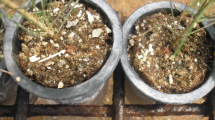Abstract
Casuarina equisetifolia Forst. is a tree crop that provides fuel wood, land reclamation, dune stabilization, and scaffolding for construction, shelter belts, and pulp and paper production. C. equisetifolia fixes atmospheric nitrogen through a symbiotic relationship with Frankia, a soil bacterium of the actinobacteria group. The roots of C. equisetifolia produce root nodules where the bacteria fix atmospheric nitrogen, which is an essential nutrient for all plant metabolic activities. However, rooted stem cuttings of elite clones of C. equisetifolia by vegetative propagation is being planted by the farmers of Pondicherry as costeffective method. As the vegetative propagation method uses inert material (vermiculite) for rooting there is no chance for Frankia association. Therefore after planting of these stocks the farmers are applying 150 kg of di-ammonium phosphate (DAP)/acre/year. To overcome this fertilizer usage, the Frankia-inoculated rooted stem cuttings were propagated under nursery conditions and transplanted in the nutrient-deficient soils of Karaikal, Pondicherry (India), in this study. Under nursery experiments the growth and biomass of C. equisetifolia rooted stem cuttings inoculated with Frankia showed 3 times higher growth and biomass than uninoculated control. These stocks were transplanted and monitored for their growth and survival for 1 year in the nutrient-deficient farm land. The results showed that the rooted stem cuttings of C. equisetifolia significantly improved growth in height (8.8 m), stem girth (9.6 cm) and tissue nitrogen content (3.3 mg g−1) than uninoculated controls. The soil nutrient status was also improved due to inoculation of Frankia.




Similar content being viewed by others
References
Arnone JA and Gordon JC 1990 Effect of nodulation nitrogen fixation and CO2 enrichment on the physiology, growth and dry mass allocation of seedlings of Alnus rubra Bong. New Phytol. 116 55–66
Benson DR and Silvester WB 1993 Biology of Frankia strain, actionomycete symbionts of actinorhizal plants. Microbiol. Rev. 57 293–319
Echhab H, Anatous M, Ducousto M, Nourrssion –Mountour S, Dupponnis SR and Lahlour H 2007 Successful nodulation of Casuarina by Frankia in axenic conditions. J. Appl. Microbiol. 103 1728–1737
Jackson ML 1973 Soil chemical analysis (New Delhi: Prentice Hall)
Karthikeyan A, Chandrasekaran K and Geetha M 2012 Frankia sp CeCo1 16S Ribosomal RNA gene partial sequence. NCBI, USA, Accession No. JQ 412181
Lefrancois E, Quoreshi A, Khasa D, Fung M, Whyte L G, Roy S and Greer C.W 2010 Field performance of alder – Frankia symbionts for the reclamation of oil stands sites. Appl. Soil. Ecol. 46 183–191
Lesueur O and Duponnois R 2005 Relations between rhizobial nodulation and root colonization of Acacia crassicarpa provinces by an arbuscular mycorrhizal fungus Glomus intrradices Schenk and Smith or an ectomycorrhizal fungus Pisolithus tinctorius coke & couch. Ann. For. Sci. 62 467–474
Lumini E, Bosco M, Puppi G, Isopi R, Fralergrani M, Bureti E and Faviki F 1994 Field performance of Alnus cordata Loisel (India alba) inoculated with Frankia and VA mycorrhizal strains in mine spoil afforestation plots. Soil. Biol. Biochem. 26 659–661
Muthukumar T and Udaiyan, K 2010 Growth response and nutrient utilization of Casuarina equisetifolia seedlings inoculated with bio inoculants under tropical nursery conditions. New. For. 40 101–118
Nicodemus A 2009 Casuarina a guide for cultivation (ICFRE Publication)
Reddell, P, Rosbrook PA, Bowen GO and Gnale D 1988 Growth response in Casuarina cunnighamiana plantings inoculation with Frankia . Plant Soil 108 76–86
Shantharam S and Mattoo AK 1997 Enhancing biological nitrogen fixation: an appraisal of amount and alternative technologies for N in put into plants. Plant Soil 194 205–216
Shipton WA and Burgraff AJP 1983 Aspects of the cultural behaviour of Frankia and possible ecological implication. Can. J. Bot. 61 2783–2792
Torrey JG 1983 Root development and root nodulation in casuarinas; in Casuarina ecology management and utilization (ed) SJ Midgley, JW Turnbul and RP Johnstorn (Canberra: Australia CSIRO publishing) pp 180–192
Vergnaud L, Chaboud A, Prin Y and Rougier M 1985 Pre infection events in the establishment of Alnus – Frankia symbiosis: development of spot inoculation technique. Plant Soil 87 67–78
Yamanka, T, Li CY, Bormann BT and Okabe H 2003 Tripartite association in an alder: effects of Frankia and Alpova diplophloeus on the growth, nitrogen fixation and mineral acquisition of Alnus tenuifolia. Plant Soil 254 179–186
Acknowledgements
The authors thank the Department of Biotechnology, New Delhi, for financial support for a research project (Project No. BT/PR10464/AGR/21/239/2008).
Author information
Authors and Affiliations
Corresponding author
Additional information
[Karthikeyan A, Chandrasekaran K, Geetha M and Kalaiselvi R 2013 Growth esponse of Casuarina equisetifolia Forst. rooted stem cuttings to Frankia in nursery and field conditions. J. Biosci. 38 1–7] DOI 10.1007/s12038-013-9362-3
Rights and permissions
About this article
Cite this article
Karthikeyan, A., Chandrasekaran, K., Geetha, M. et al. Growth response of Casuarina equisetifolia Forst. rooted stem cuttings to Frankia in nursery and field conditions. J Biosci 38, 741–747 (2013). https://doi.org/10.1007/s12038-013-9362-3
Published:
Issue Date:
DOI: https://doi.org/10.1007/s12038-013-9362-3




